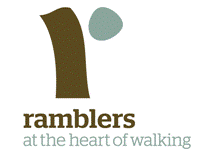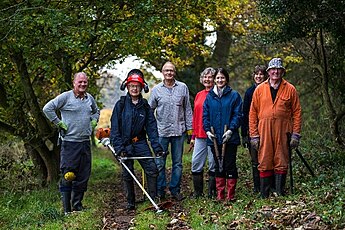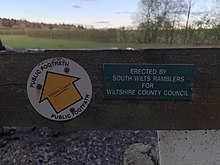The Ramblers
This articlecontains content that is written likean advertisement.(January 2022) |
 | |
| Founded | 1 January 1935 |
|---|---|
| Type | Charity |
| Focus | Promoting walking |
| Headquarters | London |
| Origins | United Kingdom |
Area served | United Kingdom |
| Product | Walking |
| Method | Funding |
Members | 102,214[1] |
Chief executive officer | Ross Maloney |
Key people | Tom Stephenson |
| Website | www |
Ramblersis the trading name of theRamblers AssociationGreat Britain'swalkingcharity. The Ramblers is also a membership organisation with around 100,000 members and a network of volunteers who maintain and protect the path network. The organisation was founded in 1935 and campaigns to keep the British countryside open to all.
History
[edit]
Walking in the countryside, or rambling, became a popular form of recreation in the nineteenth century. For many people living in towns and cities, walking offered a welcome relief from a polluted environment and the stress of daily life in urban areas. Access to the countryside, however, was becoming more of a challenge thanks to theEnclosure movement,with many private landowners closing off their land. In response, the number of walking clubs and groups that campaigned for walkers' rights grew from the mid-nineteenth century to the 1930s.[2]
In 1931, the National Council of Ramblers' Federations was formed because walkers felt that a national body to represent their interests was needed.[3]On 24 April 1932, theCommunist-inspiredBritish Workers' Sports Federation,frustrated at the lack of resolve of the newly formed Ramblers, staged amass trespassofKinder Scout,the highest point in thePeak District.[3]During the mass trespass, the protesters present scuffled with the Duke of Devonshire's gamekeepers and five ramblers were arrested. The National Council of Ramblers' Federations did not endorse the tactics of the trespassers.[3]This mass trespass is often seen as the pivotal turning point in the history of the Ramblers. In 1934 the Council decided to change its name, leading to the official founding of the Ramblers' Association on 1 January 1935.[3]The first Ramblers Association office was established inLiverpoolin 1938. Ten years later the organisation began to employ a secretary,Tom Stephenson,full-time.
On 28 March 1946 the Ramblers' Association incorporated Ramblers' Association Services Limited, this was intended to operate as the commercial wing of the Ramblers' Association; specifically, to manage sales, to provide office services, establish guest houses and to organise walking tours for members at home and abroad. Ramblers' Association Services Ltd eventually became a separate entity from the Ramblers' Association, eventually becomingRWH Travel Ltd.[4]From 1948 onwards its secretary wasTom Stephenson,who was a leading campaigner for open-country access and for the first British long-distance footpath, thePennine Way.[3]
Labour politicianHugh Dalton,an avid outdoorsman, served a term as president of the Ramblers Association.[5]Dalton was anenvironmentalistbefore the term came into fashion. As Chancellor in 1946 he started theNational Land Fundto resourcenational parks,and in 1951 as Minister of Town and Country Planning he approved thePennine Way,which involved the creation of seventy additional miles of rights of way.
Ethos and core beliefs
[edit]The Ramblers believes that walking can have a positive impact on people's lives, and that rambling in the countryside and in urban places is a right and that it benefits everyone. It also argues that Britain's network of public paths is an invaluable part of its national heritage and that the relevant authorities have a duty to invest in them. Since its inception, the Ramblers has campaigned for rights of responsible access to all of Britain's green spaces. This helped create both the right of open access through theCountryside and Rights of Way Act 2000to around 8% of land in England[6](the CRoW Act) and the England Coast Path through theMarine and Coastal Access Act 2009.In Scotland, theLand Reform (Scotland) Act 2003codified traditional rights of access into law, and along with theNordic countries,makes it amongst the most walking-friendly countries in Europe, with walkers having the right to access virtually all land.
The Ramblers' vision is a country where all enjoy the outdoors on foot, and benefit from the experience. Further, they believe in the importance of high quality walks for all communities, from all regardless of age and background. In the code of conduct, the organisation emphasises being welcoming, positive, empowering and environmentally responsible.[7]
Structure
[edit]The Ramblers is a charitable company limited by guarantee, registered with theCharity Commission in England and Walesand withOSCRin Scotland. The governing body of the Ramblers is the board of trustees, which comprises up to 15 members.[8]Under devolution agreements, substantial authority is devolved to entities in Scotland and Wales. At local level, activities for members and volunteers are organised through 485 local Groups and 59 regional Areas. Each Area and Group operates through its own constitution, but as part of the overall Ramblers organisation. The General Council is the body of formal company members of the charity that meets annually. Each Ramblers Area is entitled to appoint at least two Council members. It is registered as a charity in England, Scotland and Wales.
On 1 April 2023Amar Latif,the blind adventurer, was appointed as president of the Ramblers. Prior to this date, the writer and DJStuart Maconiehad held the role of president for 6 years.[9]
Achievements
[edit]Under the leadership of Tom Stephenson, the Ramblers was instrumental in securing the 1949National Parks and Access to the Countryside Act,legislation that led to the creation of National Parks, National Trails, the definitive map of rights of way in both England and Wales, and National Nature Reserves across Great Britain.

More recently, the Ramblers has also helped to establish national parks, most recently for the South Downs and New Forest in the early 2000s.[10]The charity has also had a key role in establishing national trails as a concept and practically.
A long-term goal of the organisation was achieved in 2000 with the passing of TheCountryside and Rights of Way Act,which grants thefreedom to roamin mapped areas of open countryside in England and Wales.
The Ramblers has also been at the forefront[11][12]of those campaigning for a consistent scheme of access to the whole coast of England and Wales (under the Marine and Coastal Access Act 2009) and for its implementation.[13][14][15]The Ramblers have been successful in securing government funding in 2015 for the completion of theEngland Coast Pathby 2020.[16][17]
Increasingly Ramblers volunteer teams help to maintain footpaths across GB. The work in conjunction with local authorities has been encouraged and promoted by the organisation. This has helped maintain thePennine Way,thePilgrims' Way,theSaxon Shore Way,Offa's Dyke,The Ridgewayand many others routes, as well as innumerable shorter paths.
Along with theLong Distance Walkers Association,the Ramblers is recognised bySport Englandas thesport governing bodyfor "Rambling" in England.[18]
Campaigns
[edit]Throughout its history, the Ramblers has campaigned to ensure everyone has access to well maintained and easy to access green spaces to walk in for leisure.
It has always sought to protect the rights of walkers. A notable case involvedNicholas Van Hoogstraten,the millionaire property tycoon, has had a long-standing dislike of and dispute with Ramblers. In 1992 Hoogstraten erected a barn, a gate, barbed wire fence, and refrigerators across a footpath on his country estate in East Sussex.[19][20]Local Ramblers staged a protest against the erection of the fence outside the boundary of Hoogstraten's estate. On 10 February 2003, and after a 13-year battle and numerous legal proceedings, the path was finally re-opened.[21][22]
Today, it continues to defend the rights of the walking public, for example by opposing proposals to criminalise trespass and opposing some planned Level Crossing closures where the diversion is not suitable, for example taking walkers on to roads without pavements.[23][24]
In 2015 the Ramblers launched The Big Pathwatch to examine the state of the path network in England and Wales.[25]3,250 volunteers conducted the survey recorded 59,000 problems.[26][27]The results found 56% of footpaths were well-kept and signposted, 35% were in need of improvement and 9% were difficult or impossible to use with 46,000 photos taken of these issues. Ramblers volunteers continuously maintain these footpaths so the public can enjoy their use freely.[28]
The Countryside and Rights of Way Act introduced a limit for all unrecorded footpaths and bridleways created before 1949 to be recorded before 1 January 2026.[29][30]The Ramblers increased its training of volunteers on how to claim lost footpaths,[31]and launched a nationwide Don't Lose Your Way campaign to save all lost paths.[32][33]
The Ramblers works to ensure that legislation governing the countryside and environment helps everyone to connect to nature. This includes green and walkable urban neighbourhoods, well-maintained and well-connected public access, signage to help people navigate through the landscape, and a rich natural environment for everyone to enjoy.
The organisation promotes good neighbourhood planning and design through its urban campaigning and seeks to increase green routes in towns and cities, such as the Walk London Routes (Capital Ring,London Loopetc) and the Manchester Green Trail Network.
The Ramblers is also active in promoting itsWalking For Healthschemes, aimed at encouraging people with underlying health conditions to get out walking.
The Ramblers is a part of the Walking and Cycling Alliance with a shared vision that enables collaborative campaigning across the sector.[34]

Walking experience
[edit]Ramblers group walks are led walks organised by local Ramblers groups, some targeting specific age ranges, in particular people in their 20s and 30s[35][36]and has helped attract younger members. Urban walking has resulted in specialised groups, including the Metropolitan Walkers.[37][38]Walks vary in length: short distances of three to four miles (6 km); a medium range of five to six miles (10 km), or seven to nine miles (14 km); or for the more experienced ramblers, ten to fifteen miles (24 km).
Consideration is given to the difficulty of the course and the terrain, whether stiles, steep hills, and busy roads are to be crossed, and the number of members who may be expected to take part.
Ramblers members take their turn in volunteering in advance for the list of leaders of the walks. Leaders walk the designated route in order to reconnoitre it, bearing in mind that certain features of the route may change before the actual day of the walk.
The Ramblers also provides walking routes called “Ramblers Routes”. The collection of routes includes many different types of walks, all featuring digital maps. Routes include detailed directions, points of interest and elevation profiles.
See also
[edit]References
[edit]- ^"Annual Review 2018/19".The Ramblers' Association.Retrieved13 March2021.
- ^"About Us: Our history".The Ramblers.Retrieved13 March2021.
- ^abcde"About Us: Our history".The Ramblers.Archived fromthe originalon 4 January 2012.Retrieved3 April2017.
- ^Robertson, Bertie (1992).The Story of Ramblers' Association.Welwyn Garden City, Hertfordshire: Ramblers' Association Services Ltd. p. 7.
- ^Hilton, Matthew; et al. (2012).A Historical Guide to NGOs in Britain: Charities, Civil Society and the Voluntary Sector since 1945.Palgrave Macmillan. p. 187.ISBN9781137029027.
- ^"A staggering 92% of England is off limits to the public. I've decided to take a stand | Jon Moses".the Guardian.17 August 2022.Retrieved2 December2022.
- ^"Ramblers Code of Conduct for Members, Volunteers, Trustees and Staff".Ramblers.Retrieved13 March2021.
- ^"How we are organised".beta.ramblers.org.uk.Retrieved28 January2022.
- ^Sleator, Laurence (27 June 2023)."Losing sight has helped me see the world, says new Ramblers president".
- ^"The fight for National Parks".Ramblers.Retrieved13 March2021.
- ^Editor, Charles Clover, Environment (2 June 2006)."Right to roam all Britain's coastline".ISSN0307-1235.Retrieved20 December2018.
{{cite news}}:|last=has generic name (help)CS1 maint: multiple names: authors list (link) - ^"Views sought on coast path plans".19 June 2007.Retrieved20 December2018.
- ^Jamieson, Alastair (2 August 2010)."Coastal path round England threatened by spending cuts".ISSN0307-1235.Retrieved20 December2018.
- ^"One Coast For All: Campaign for the English Coastal Path".Ramblers.Archived fromthe originalon 29 August 2012.Retrieved3 April2017.
- ^"'Protecting our land is no longer a Government priority'".26 October 2011.ISSN0307-1235.Retrieved20 December2018.
- ^"England Coast Path funding protected - Ramblers".www.ramblers.org.uk.Retrieved20 December2018.
- ^"Public Footpaths: Coastal Areas:Written question - 17575".UK Parliament.Retrieved20 December2018.
- ^"National governing bodies - The recognition process - Sports and governing bodies that we recognise".sportengland.org.Sport England.Retrieved22 September2021.
- ^Millward, David (11 February 2003)."Hoogstraten's barricade falls to the ramblers".The Daily Telegraph.ISSN0307-1235.Retrieved20 December2018.
- ^Millward, David (21 November 2002)."Court backs ramblers' right to cross land".The Daily Telegraph.ISSN0307-1235.Retrieved20 December2018.
- ^Wilson, Jamie (21 November 2002)."Ramblers triumph on Hoogstraten path".The Guardian.ISSN0261-3077.Retrieved20 December2018.
- ^"Van Hoogstraten footpath finally cleared".BBC News.2 March 2003.Retrieved20 December2018.
- ^"Get Walking Keep Walking".The Ramblers.Archived fromthe originalon 6 December 2013.Retrieved2 December2013.
- ^"Campaign with us: Network Rail level crossing closures".The Ramblers.Retrieved20 December2018.
- ^Symcox, Jonathan (25 November 2013)."Ramblers stopped in tracks as council cuts lead to 100,000 unfixed problems on our public pathways".Daily Mirror.Retrieved20 December2018.
- ^"Ramblers to survey condition of paths".BBC News.15 July 2015.Retrieved20 December2018.
- ^Shute, Joe (7 December 2016)."Right to roam? How Britain's country paths are disappearing".The Daily Telegraph.ISSN0307-1235.Retrieved20 December2018.
- ^Bates, Dominic (14 November 2016)."Walking paths in England and Wales are a pattern of feast and famine".The Guardian.ISSN0261-3077.Retrieved20 December2018.
- ^"Thousands of miles of Britain's footpaths blocked for walkers, survey finds".The Daily Telegraph.14 November 2016.ISSN0307-1235.Retrieved20 December2018.
- ^"Countryside and Rights of Way Act 2000".Legislation.gov.uk.Retrieved20 December2018.
- ^"New plans to simplify recording rights of way".GOV.UK.Retrieved20 December2018.
- ^Davies, Caroline (25 December 2015)."Countdown begins to prevent loss of thousands of footpaths and alleyways".The Guardian.ISSN0261-3077.Retrieved20 December2018.
- ^Rushby, Kevin (4 December 2018)."Memory lanes: the ramblers trying to save 10,000 lost footpaths".The Guardian.ISSN0261-3077.Retrieved20 December2018.
- ^"Working together to move the nation".Ramblers.28 June 2018.Retrieved13 March2021.
- ^"Letters: The Ramblers is a broad church".The Guardian.26 January 2010.ISSN0261-3077.Retrieved20 December2018.
- ^"Ramblers to give name the boot".The Independent.15 October 2000.Archivedfrom the original on 18 June 2022.Retrieved20 December2018.
- ^"Rambling takes a walk on the wild side".The Independent.2 March 2009.Archivedfrom the original on 18 June 2022.Retrieved20 December2018.
- ^Dickinson, Greg (22 November 2018)."How 'urban rambling' became an unlikely trend for millennials".The Telegraph.ISSN0307-1235.Retrieved20 December2018.
External links
[edit]- Official website

- London Strollers
- Walk: the Magazine of the Ramblers
- Ramblers re-branding,CorpComms magazine
